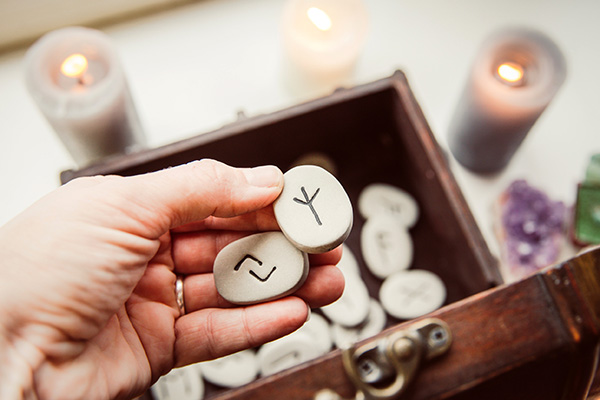How to Start Your Day with an Inspiring Rune Meditation
 The runes may originate from an ancient era, yet their insights are eternal.
The runes may originate from an ancient era, yet their insights are eternal.
Initially carved into stone and wood by the Germanic and Norse cultures over a millennium ago, runes represent more than just an old writing system. They embody sacred symbols, each one signifying archetypal truths, elemental forces, and spiritual consciousness.
Warriors, healers, visionaries, and travelers carried these symbols as charms to shield themselves, gain insights, and connect with the unseen energies of existence.
In an age overrun by transient digital communications and materialistic values, the ancient Nordic runes continue to convey their ancestral wisdom throughout the ages.
These are energetic sigils—mystical symbols crafted to elicit transformation, inspire clarity, and restore equilibrium with the rhythms of nature and spirit.
Every rune vibrates with a distinct frequency—a metaphysical key that unlocks personal insight, inner strength, and spiritual evolution. Carved into stone by hands now long gone, the runes carry the significance of sacred intent.
They remind us that language and symbolism are tools of creative power, not merely means of communication. By integrating runes into our contemporary lives, we reconnect with an ancient mode of understanding that speaks of path, purpose, and destiny.
Runes serve as meaningful instruments for fostering modern-day mindfulness. They are not remnants of a bygone era, but keys awaiting those ready to pursue wisdom beyond superficiality and chaos.
It is in the early morning hour that the unseen is perceived, and that the distant beauty and glory, vanquishing all their ambiguity, descend upon us till they become clear as crystal, standing right before the soul ~ Sarah Smiley
They anchor us to our higher purpose even as we traverse the noise and intricacies of modern life. Whether utilized in meditation, ritual, art, divination, or quiet contemplation, the runes can instruct us to slow down and appreciate the value of each choice, symbol, and step we undertake.
You can start accessing their grounding, ancient wisdom and power with this straightforward morning ritual. This simple yet effective daily practice is created to center your energy, awaken your intuition, and activate personal empowerment. It takes only a few moments, but its impact reverberates outward, setting the tone for your entire day.
What You Need
✵ A peaceful environment and approximately five minutes of undisturbed time.
✵ A set of runes (optional, yet powerful), a rune-casting application, or a book with images of runes.
✵ A clear and focused intention for your day
Step 1 – Breathe & Ground
Find comfort seated or standing with your feet firmly upon the ground. Shut your eyes.
Take a few slow, deep breaths—in through the nose, out through the mouth. With each exhalation, let go of tension. With every inhalation, invite clarity and presence.
Now, envision roots extending from the bottom of your feet deep into the earth. Feel yourself grounded, supported, and completely anchored in this moment. This is your sacred pause before stepping into the day ahead.
Step 2 – Choose A Rune
If you possess a set of rune stones, select one intuitively. If not, utilize a rune-casting app or browse through a book featuring rune images. Concentrate on the symbol that appears first or pick the one that captures your attention most. Trust your inner guidance—your intuition knows what you require.
If you are new to the runes, consider starting with one of these three potent symbols:
✵ Sowilo – The Sun Rune: success, energy, clarity
✵ Algiz – The Elk Rune: protection, strength, higher guidance
✵ Raidho – The Journey Rune: movement, rhythm, alignment with life’s path
Step 3 – Contemplate & Reflect
Physically hold the rune in your hand (if feasible) and visualize it clearly in your mind. Allow its presence to settle into your awareness.
Ask yourself: “What quality do I need to embody today?”
Let the answer surface naturally. It may come as a thought, feeling, sensation, mental image, or simply an intuitive knowing. Allow the essence of the rune to connect with you where you stand.
Step 4 – Affirm & Align
Say a simple affirmation—aloud or in silence—that encapsulates the energy of the rune you’ve selected. Let the words resonate genuinely, even if they challenge you. Especially if they challenge you.
Here are a few examples:
✵ Sowilo: “I radiate my light with confidence and clarity.”
✵ Algiz: “I am shielded and guided at all times.”
✵ Raidho: “I advance with trust and purpose.”
Repeat your affirmation three times. As you do, sense the energy of the words settling into your body, your heart, and your mind—like a steady flow of confidence, certainty, and strength rising from within.
Step 5 – Closing
Open your eyes. Take one last conscious breath. Step into your day with purpose.
What I cherish most about engaging with the runes is their ongoing relevance. You need not be a Viking or dwell in a forest to connect with their energy. Runes are raw, sincere, and deeply meaningful—and they meet you precisely where you are.
In my experience, contemporary spiritual seekers are turning to the runes for very concrete, grounded reasons:
✵ Decisions, choices and life direction.
✵ Strengthening personal boundaries.
✵ Overcoming creative blocks.
✵ Building confidence before significant meetings or events.
✵ Gaining emotional clarity in challenging relationships.
In these instances, the runes evolve into more than mere symbols. They transform into companions, guiding lights, and reminders of the deeper flow beneath the tumult.
It’s not about asking the runes to mend your life. It’s about harnessing their ancient resonance to awaken your inner wisdom—so you can greet the day with presence, strength, and intent.
Experience the difference when you start your day with sacred clarity and rooted purpose. The change may seem subtle at first—but over time, it becomes a transformation in how you navigate the world. And that, indeed, is the quiet strength of ancient wisdom in contemporary life.
|
Runa is a reader endowed with unique gifts, serving as a blessing to others and her community. She is spiritually, artistically, and creatively gifted, nurturing her spirit through selfless efforts with incarcerated youth while maintaining her reading practice in Germany and with clients globally. As a Rune specialist, Reiki Master, and gifted oracle reader, she is always accompanied by her Northern Light Guides during every session. Alongside her empathetic, direct truths and non-judgmental readings, Runa infuses positive energy that alleviates burdens and illuminates a pathway to future aspirations. From an early age, she could interpret the energy of those surrounding her; however, her exploration of ancient runes and symbols opened a book of insights that help and guide others on their journeys. Runa has read for over 20,000 clients from various backgrounds, including numerous corporate clients. She runs her own reading practice in Germany, where she resides with her husband and beloved cat, “Monster.” For over 15 years, she has motivated, enriched, and empowered the lives of both adults and teens, assisting them in embracing their true selves and manifesting their dreams. If you seek a reading from this extraordinary Rune goddess, you can find Runa at PsychicAccess.com |
Beginning your day with an inspiring rune meditation can lay a positive foundation for the hours ahead. Runes, ancient symbols used for centuries as a tool of divination and spiritual insight, can be integrated into your morning routine, allowing you to harness their energy and wisdom as you approach the challenges and opportunities of the day ahead.
To initiate your day with a rune meditation, locate a quiet and comfortable area where you can sit or recline free from distractions. Close your eyes and take a few deep breaths to center yourself and clear your thoughts. As you inhale and exhale, concentrate on releasing any tension or negativity you might be carrying.
Then, select a rune that resonates with you or one that you find yourself drawn to. Each rune possesses its own distinct meaning and energy, making it crucial to choose one that aligns with your intentions for the day. Rune sets can be found online or at metaphysical shops, or you can simply visualize the symbol in your mind.
Once you’ve selected your rune, hold it in your hand or position it in front of you where you can easily see it. Spend some time examining the symbol and contemplating its meaning. What message might it be conveying to you? How can you channel its energy into your day?
Now, close your eyes and picture the rune radiating a bright, white light. Imagine this light enveloping your entire being, from head to toe, and feel the warmth and power flowing through you. As you meditate on the rune, silently repeat its name or mantra, allowing its energy to permeate your subconscious mind.
While you continue focusing on the rune, notice any thoughts or feelings that surface. Is there a specific area of your life that requires attention or guidance? Are there any obstacles or challenges you need to confront? Permit the rune to communicate with you and provide its wisdom and support.
After a few minutes of meditation, take a deep breath and open your eyes. Notice the energy of the rune still surrounding you, guiding and protecting you throughout the day. Carry its message with you as you go about your daily activities, and trust that its influence will assist you in overcoming any challenges you may encounter.
By starting your day with an empowering rune meditation, you establish a positive and inspiring atmosphere for the hours ahead. Take the time to engage with the ancient wisdom of the runes, allowing their energy to guide you on your journey of self-discovery and personal growth. Continue reading



















